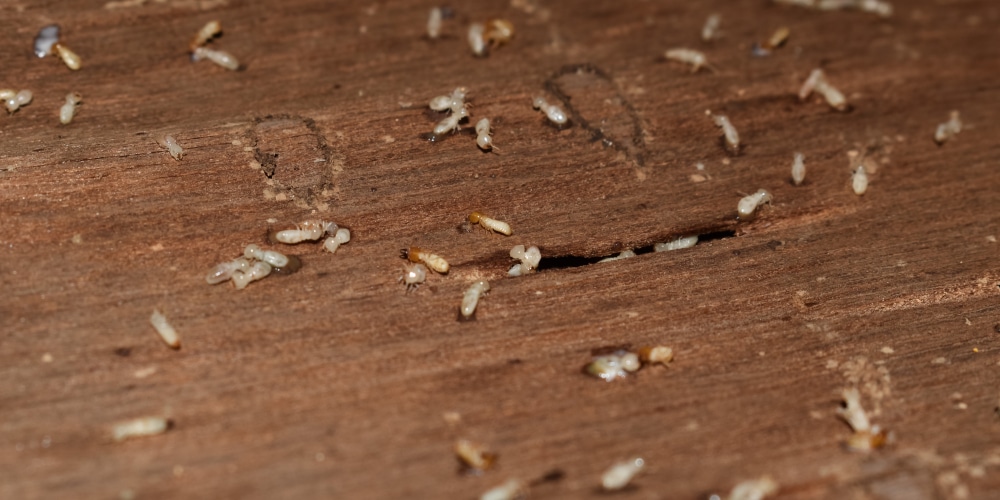
How to Spot the Signs of Termites in Kitchen Cabinets
March 11, 2023
By Daniel Baldwin, BCE, CCFS, CP-FS
Drywood and subterranean termites are destructive insects that can cause extensive damage to wood structures over time. Over $2 billion annually is spent across the US to manage or prevent termite infestations. These wood-destroying critters can go undetected in your home for years unless you know how to spot the signs of these small pests.
What are termites?
Termites are small insects that eat the cellulose in wood, and their burrows make tunnels that serve as places to live and raise families. Worker termites are a pale white color, measure 3-4 mm in length, and rarely are seen unless a piece of rotting wood or one of their foraging mud tubes is broken open. They look physically similar to ants, although their antennae are straight, not bent, with forewings and hind wings that are equal in size.
Swarmer termites are larger, at 4 mm long, with dark brown coloring. Some swarmers have wings, but quickly lose their wings after emerging from the nest.
Termites are around throughout the year, but you’ll typically be able to see swarmers during the spring.

What causes termites?
Termites can gain entry to your home and kitchen in several ways. These insects are not only attracted to wood, they’re also drawn to moisture. So if you have leaking pipes in or around your home, poor drainage issues, or wood too close to your foundation, termites will be attracted to it and gain entry through cracks or gaps. Even small openings around window trims and doors can let termites move into your home, burrow into wood cabinets, and begin raising colonies.
Are termites harmful to humans?
Some people are sensitive to termites and can have allergic reactions or asthma attacks when the dust of the insects’ nests gets spread around the home through the ventilation system. People might also have allergic reactions to termite droppings or saliva.
In general, termites aren’t known to carry diseases that can infect humans, although these insects are liable to sting or bite when threatened.
Signs of termites in kitchen cabinets
Termite damage in wood kitchen cabinets can be extensive because their activity can hollow out the cupboards from the inside.
Here are some ways to determine if there are termites in kitchen cupboards:
- Flying insects: Swarming termites—which are the termites that have wings and leave their colonies to reproduce and form new families once or twice a year—can be found flying around your kitchen’s light fixtures. They’re active in the spring and fall seasons.
- Wings: If you find discarded wings on the floor, near windows, or on kitchen counters, this indicates that the swarming insects have decided to shed their wings and settle into your home.
- Bumps: Look for small bumps or swelling on areas of your kitchen cabinets. This indicates drywood termites in cabinets. Tiny pinholes in cabinets are another sign.
- Noises: If you suddenly hear a hollow sound from inside your cabinets, termites may already be feeding on the wood fibers and weakening your cupboards.
- Travel tubes: Termite shelter tubes are small tunnels they create from mud and soil to get from their nests to their food source.
- Droppings: Termites’ feces look like bits of sawdust. If you find little mounds of sawdust-like droppings around your cupboards, this is a sign of termites in kitchen cabinets.
- Rotting wood: If your wood cabinets begin to rot and weaken, it may be due to termite damage in kitchen cabinets. An accumulation of moisture where the termites are nesting, in addition to the hollowing out of the wood, will deteriorate your wood cabinets.
How to prevent termites
Termite infestations are a major source of stress for homeowners, but you can help protect your kitchen cabinets from termite infestations taking hold. Here are a few tips for termite prevention:
- Let as much sunlight flood your kitchen as possible. These critters love moist, dark environments and don’t like the sun or heat.
- Seal up all cracks and gaps in your home’s foundation and around door and window casings.
- Fix leaky pipes and other water sources that attract termites to your home.
- Work with Hawx Pest Control to discuss preventive measures to protect your home from termites.
Pest control solutions
At Hawx Pest Control, we will devise a treatment plan specific to your needs for termite management in residential areas. Our highly trained professionals thoroughly inspect your property to determine the location of termites and how they’re gaining entry into your home.
Our technicians establish a thorough barrier around your home’s perimeter during each service call. Hawx’s termite protection service plan includes the installation of specialized bait stations that weaken and discourage termite colonies from infiltrating your home.
We provide homeowners with free estimates concerning your issues with termites. Our staff of honest, experienced professionals will get the job done using the most up-to-date tools and technologies available so you can rest easy and enjoy your home without worrying about termites in your kitchen cabinets.
RELATED POSTS



